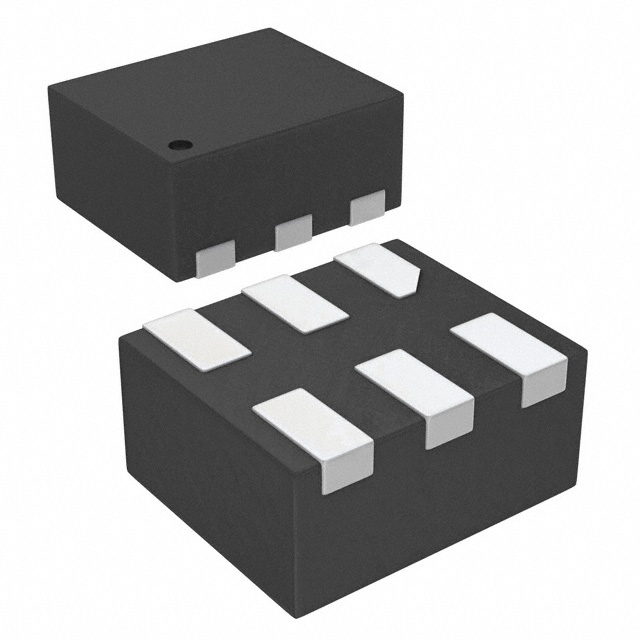NLU1G04CMUTCG
Basic Information Overview
- Category: Integrated Circuit (IC)
- Use: Logic Gate
- Characteristics: Single Inverter Gate
- Package: SOT-23
- Essence: Complementary Metal-Oxide-Semiconductor (CMOS) technology
- Packaging/Quantity: Tape and Reel, 3000 units per reel
Specifications
- Supply Voltage Range: 1.65V to 5.5V
- Input Voltage Range: 0V to VDD
- Output Voltage Range: 0V to VDD
- Maximum Operating Frequency: 20MHz
- Propagation Delay: 4.5ns (typical)
- Input Capacitance: 3pF (typical)
- Output Current: ±8mA
Detailed Pin Configuration
The NLU1G04CMUTCG has a total of 5 pins:
- GND (Ground): Connected to the ground reference.
- A (Input): Input pin for the logic signal.
- Y (Output): Output pin for the inverted logic signal.
- NC (No Connection): This pin is not connected and should be left unconnected.
- VDD (Power Supply): Connected to the positive supply voltage.
Functional Features
- Single inverter gate with CMOS technology.
- Provides logic inversion of the input signal.
- Low power consumption due to CMOS technology.
- Wide operating voltage range allows compatibility with various systems.
- High-speed operation with low propagation delay.
- Small package size (SOT-23) enables space-efficient designs.
Advantages and Disadvantages
Advantages: - Low power consumption makes it suitable for battery-powered devices. - Wide operating voltage range provides flexibility in different applications. - Compact package size allows for space-saving designs. - High-speed operation ensures quick signal processing.
Disadvantages: - Limited output current may restrict its use in certain applications requiring higher current capabilities. - The absence of Schmitt trigger functionality limits its noise immunity.
Working Principles
The NLU1G04CMUTCG is a single inverter gate that utilizes CMOS technology. It consists of complementary P-channel and N-channel MOSFETs connected in series between the power supply (VDD) and ground (GND). The input signal is applied to the gate of the N-channel MOSFET, while the output is taken from the junction of the two MOSFETs. When the input is high, the N-channel MOSFET turns on, allowing current to flow from VDD to GND, resulting in a low output voltage. Conversely, when the input is low, the N-channel MOSFET turns off, and the P-channel MOSFET turns on, pulling the output voltage to VDD.
Detailed Application Field Plans
The NLU1G04CMUTCG can be used in various digital logic applications, including but not limited to:
- Microcontrollers and microprocessors.
- Data communication systems.
- Memory circuits.
- Signal conditioning circuits.
- Industrial automation systems.
- Consumer electronics.
- Automotive electronics.
Detailed and Complete Alternative Models
- SN74LVC1G04DBVR: Single Inverter Gate, SOT-23 package, 1.65V to 5.5V supply voltage range.
- MC74VHC1GU04DTT1G: Single Inverter Gate, SOT-23 package, 2V to 5.5V supply voltage range.
- TC7SZ04FU(T5L,F): Single Inverter Gate, SOT-353 package, 1.65V to 5.5V supply voltage range.
These alternative models offer similar functionality and can be considered as substitutes for the NLU1G04CMUTCG in various applications.
In conclusion, the NLU1G04CMUTCG is a single inverter gate IC with CMOS technology. It provides logic inversion of input signals and operates at a wide voltage range. With its compact package size and low power consumption, it finds applications in diverse fields such as microcontrollers, data communication systems, and consumer electronics. Alternative models are available to suit specific requirements.
Seznam 10 běžných otázek a odpovědí souvisejících s aplikací NLU1G04CMUTCG v technických řešeních
Sure! Here are 10 common questions and answers related to the application of NLU1G04CMUTCG (Natural Language Understanding for Technical Solutions):
1. What is NLU1G04CMUTCG? NLU1G04CMUTCG stands for Natural Language Understanding for Technical Solutions. It is a technology that enables computers to understand and interpret human language in the context of technical domains.
2. How does NLU1G04CMUTCG work? NLU1G04CMUTCG uses machine learning algorithms to analyze and process natural language input. It leverages techniques such as text classification, named entity recognition, sentiment analysis, and semantic parsing to extract meaning from text.
3. What are the benefits of using NLU1G04CMUTCG in technical solutions? Using NLU1G04CMUTCG in technical solutions can improve user experience, automate processes, enhance customer support, enable intelligent search, and facilitate knowledge management.
4. In which industries can NLU1G04CMUTCG be applied? NLU1G04CMUTCG can be applied in various industries such as healthcare, finance, e-commerce, telecommunications, manufacturing, and customer service, where there is a need to understand and process technical information.
5. Can NLU1G04CMUTCG handle multiple languages? Yes, NLU1G04CMUTCG can be trained to handle multiple languages. However, its effectiveness may vary depending on the availability and quality of training data for each language.
6. Is NLU1G04CMUTCG capable of understanding complex technical jargon? Yes, NLU1G04CMUTCG can be trained to understand complex technical jargon by providing it with relevant domain-specific training data. This allows it to accurately interpret and respond to technical queries.
7. How accurate is NLU1G04CMUTCG in understanding natural language input? The accuracy of NLU1G04CMUTCG depends on the quality and quantity of training data, as well as the effectiveness of the machine learning algorithms used. With proper training and fine-tuning, it can achieve high levels of accuracy.
8. Can NLU1G04CMUTCG be integrated with existing technical solutions? Yes, NLU1G04CMUTCG can be integrated with existing technical solutions through APIs or SDKs. This allows developers to leverage its capabilities without having to build the entire system from scratch.
9. What are some potential use cases for NLU1G04CMUTCG in technical solutions? Some potential use cases include chatbots for technical support, intelligent search engines for technical documentation, automated ticket routing systems, sentiment analysis for customer feedback, and voice assistants for technical troubleshooting.
10. Are there any limitations or challenges associated with NLU1G04CMUTCG? Some limitations include the need for large amounts of training data, potential biases in the training data, difficulty in handling ambiguous queries, and the need for continuous updates and improvements as language evolves.


